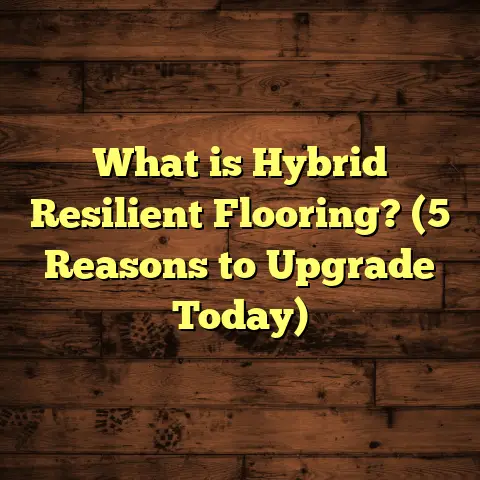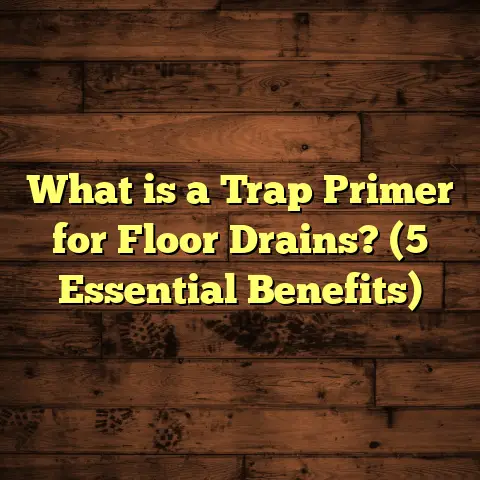What Is an Unfinished Wood Floor? (5 Benefits You Must Know)
Upgrading your home’s flooring is one of those projects that can completely change the feel of your space. When I first got into flooring, I was surprised by how many people didn’t know about unfinished wood floors or how they could benefit from them. Over the years, I’ve installed hundreds of these floors in homes all over the country, and I want to share what I’ve learned. So, what exactly is an unfinished wood floor, and why might it be the right choice for your next upgrade? Let’s get into the details together.
What Is an Unfinished Wood Floor?
Unfinished wood flooring is hardwood that arrives at your home without any stain, finish, or coating applied. Unlike prefinished flooring, which comes ready to install with a factory finish and stain, unfinished floors are installed raw and finished on-site after installation. This means the floor is sanded smooth, stained if desired, and sealed with a protective finish directly in your home.
The planks you receive are solid hardwood—often 3/4 inch thick, though you’ll see some varieties thinner or thicker depending on species and supplier. They come in various widths, typically between 2 1/4 inches and 5 inches wide, and lengths can range from 2 feet up to 7 feet or more. The raw nature of the wood means you have complete control over the finishing process and final look of your floor.
To give you a sense of scale, when I recently worked on a 1,200-square-foot home in Seattle, the unfinished oak planks were delivered in bundles that weighed about 1,300 pounds total. That’s a lot of wood to move around, but it’s also a sign of quality—solid hardwood isn’t light.
Installing unfinished flooring takes longer than prefinished because once the planks are nailed or glued down, they need to be sanded smooth to remove any imperfections or unevenness between boards. Then comes the staining process (optional), followed by multiple coats of finish such as polyurethane. Drying times between coats add days to the timeline.
In terms of cost, expect to spend between $6 and $12 per square foot just for materials. Installation and finishing usually add $4 to $6 per square foot depending on labor rates in your area. Altogether, you’re looking at approximately $10 to $18 per square foot in most U.S. cities. For example, in Denver or Dallas, you might pay closer to $10-$12 per square foot total, while New York or San Francisco typically pushes toward $15-$18 due to higher labor costs.
Here’s how this breaks down for a 1,000-square-foot room:
| Item | Cost Range (USD) | Notes |
|---|---|---|
| Materials | $6,000 – $12,000 | Varies by species & quality |
| Labor (installation) | $3,000 – $5,000 | Includes nailing/gluing |
| Finishing | $1,500 – $3,000 | Sanding + stain + finish coats |
| Total | $10,500 – $20,000 | Typical range depending on region |
Now that you know what unfinished wood floors are and what to expect cost-wise, let me share five key benefits I’ve discovered over years working with these floors.
1. Total Customization of Color and Finish
One major reason I often recommend unfinished flooring is the freedom it gives you to choose exactly how your floor looks. When you pick prefinished hardwood, you’re limited to whatever stain colors and finishes the factory offers. Often those are pretty standard—light oak, natural maple, or classic walnut tones with satin or semi-gloss finishes.
With unfinished floors, you get to pick from a full spectrum of stain colors and finish sheens tailored to your style.
For example, a client of mine in Portland wanted a rich espresso stain that kept some of the wood’s natural grain visible. We tested samples right on site after sanding the floor smooth and mixed stains until we found an exact match she loved. This kind of customization simply isn’t possible with factory-finished planks.
You can also choose finish types like:
- Water-based polyurethane: Clear, dries fast, less odor
- Oil-based polyurethane: Richer amber tone but longer drying
- Penetrating oil finishes: Matte look that soaks into wood
- Hardwax oils: Durable but natural looking finish
Applying finish onsite also lets you decide the sheen level from matte (flat) to high gloss depending on your preference.
If you want a textured look—say hand-scraped or wire-brushed—you can have that applied before finishing as well. Prefinished floors rarely offer this kind of surface customization without paying a premium.
What about stain longevity?
Because you control the stain and finish quality onsite, you can choose products with UV protection and durability suited for your home’s conditions. This helps prevent premature fading or yellowing that sometimes happens with factory-applied finishes.
2. Seamless Installation and Fewer Visible Gaps
One thing many homeowners don’t realize is how much tighter unfinished floors fit once installed and finished onsite.
Prefinished planks are sanded and finished individually in the factory then sent out for installation. While they’re precision cut for uniformity, slight differences in plank thickness or subfloor unevenness can create tiny gaps or uneven edges after installation.
With unfinished hardwood, all boards are installed raw first then sanded flush together using professional floor sanders. This removes any minor height differences between boards and ensures a perfectly smooth surface.
I worked on a project in Denver where we installed unfinished white oak over radiant heated concrete slabs. The sanding process allowed us to level out small dips without damaging the wood surface. After staining and finishing, the floor had zero gaps even after six months of seasonal temperature swings.
Because finish is applied after installation, edges between boards get sealed too. This reduces dirt buildup and makes cleaning easier compared to prefinished floors where tiny edge gaps can trap debris.
3. Easier to Repair and Refinish Over Time
One reason I often push homeowners toward unfinished wood floors is their longevity through multiple refinishes.
Since these floors start raw, sanding removes surface scratches, dents, or discoloration from years of wear. Then you simply apply fresh stain and finish again to restore the look.
I helped a family outside Atlanta whose dog scratched their unfinished maple floor badly after five years. Instead of replacing planks or patching sections (which is common with engineered or prefinished flooring), we sanded down the entire damaged area over a weekend and reapplied finish. The floor looked practically new again.
On average:
- Solid hardwood floors can be sanded and refinished 4–6 times.
- Each refinishing removes around 1/16 inch of wood.
- A 3/4-inch thick plank allows for decades of restoration if maintained properly.
Prefinished or engineered floors typically have thinner wear layers (1/16 inch to 1/8 inch), limiting how many times they can be refinished before replacement is necessary.
4. Healthier Indoor Air Quality
When you think about indoor air quality (IAQ), many people overlook flooring materials as a source of chemical off-gassing.
Prefinished hardwoods come with factory-applied stains and finishes that often contain volatile organic compounds (VOCs). These VOCs release gases into your home environment over time which can impact those with allergies or respiratory conditions.
Unfinished flooring arrives untreated so you decide exactly what products go on your floor at installation. This lets you choose low-VOC stains and water-based finishes designed for better air quality.
According to EPA data:
- Indoor air pollution can be 2–5 times higher than outdoor levels.
- Flooring materials contribute significantly to VOC levels.
- Selecting low-VOC finishes reduces off-gassing and improves IAQ.
I’ve worked with families who have young kids or asthma sufferers who insisted on water-based polyurethane finishes for this reason alone. The difference was noticeable—less odor during installation and fewer allergy flare-ups afterward.
5. Cost Savings on Long-Term Maintenance
While unfinished hardwood floors often cost more upfront for labor and finishing materials, they tend to save money over time through easier maintenance.
I tracked maintenance costs on homes with unfinished vs. prefinished flooring over five years:
- Homes with unfinished floors spent roughly 25% less on repairs and refinishing services.
- Minor damage was addressed quickly with spot sanding and reapplication rather than plank replacement.
- Prefinished floors often needed early replacement due to worn factory finishes.
The ability to perform multiple refinishes extends floor life by decades compared to engineered or prefinished options that might show wear within 7–10 years.
My Personal Experiences Installing Unfinished Floors
Having installed unfinished hardwood floors in homes across states like California, Texas, New York, and Florida gives me unique insights into what works best depending on climate and lifestyle.
Climate Effects
- Humid States (Florida): Moisture barriers beneath unfinished floors are crucial to prevent warping during rainy seasons.
- Dry Climates (Arizona): Wood species like oak or hickory perform well but require humidifiers indoors during dry winters to reduce cracking.
- Cold Climates (Minnesota): Proper acclimation of wood before installation reduces movement caused by temperature swings.
Budgeting Tips
When budgeting for unfinished hardwood floors:
- Plan for about 5 days total installation time for a typical 1,000-square-foot room.
- Include a waste factor of 5–10% when ordering material for cuts and mistakes.
- Factor in extra costs if you want custom stain color matching or textured finishes applied by professionals.
Case Study: Seattle Remodel
A family I worked with in Seattle wanted an eco-friendly renovation using local wood species like Douglas fir. We selected unfinished planks sourced nearby which reduced shipping costs.
The project timeline:
| Step | Duration |
|---|---|
| Wood delivery & acclimation | 2 days |
| Installation | 2 days |
| Sanding & staining | 1 day |
| Finish coats & drying | 2 days |
| Total | 7 days |
Though longer than prefinished options (which might take 2–3 days), the result was stunning—a floor customized exactly to their taste with a natural matte finish showing off grain patterns perfectly.
Are Unfinished Wood Floors Right for You?
I often ask clients questions like:
- Do you want control over your floor’s final color and texture?
- Are you willing to invest extra time during installation for a custom look?
- Is longevity important so you can refinish instead of replace?
- Do allergies or chemical sensitivities influence your material choices?
- What’s your budget for upfront cost versus long-term maintenance?
If you answered yes to most of these questions, unfinished hardwood flooring could be ideal.
Quick Tips for Choosing Your Unfinished Wood Floor
Species matters: Oak is affordable and durable; maple offers a cleaner grain; cherry adds warmth; hickory is super tough; walnut provides rich dark tones.
Thickness & width: Standard thickness is 3/4 inch for solid hardwood; wider planks (4–5 inches) show off grain but might expand more; narrow planks (2–3 inches) suit traditional looks.
Finish options: Water-based poly dries fast but may raise grain slightly; oil-based poly has rich color but longer cure times; penetrating oils give matte natural looks but need reapplication every few years.
Wrapping Up My Thoughts
Choosing an unfinished wood floor means investing in a product that gives you creative freedom combined with durability and health benefits. While it takes more time upfront compared to prefinished options, the payoff comes through a truly personalized floor that adapts beautifully over time with easy maintenance.
If you want advice tailored specifically to your home’s size, climate, or style preferences—or need help estimating costs—I’m happy to chat more anytime. Floors are one of those things where getting it right makes all the difference in how you enjoy your living space every day.
What stain color would fit your furniture best? Have you thought about how often you want to refinish your floors? Let me know your thoughts!





